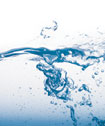Water Purification Systems
 …From the pages of Suburban Home and Garden…
…From the pages of Suburban Home and Garden… Changing the way you drink and think about H2O.
According to a 2001 report by the World Wildlife Fund, bottled water is the fastest growing segment of the beverage industry in the world, worth up to $22 billion a year. If you’re one of the millions of Americans who have bottled water delivered to your home, you’re contributing about $60 per month to that astronomical number. That’s $720 per year for drinking water, when you’re probably still using ordinary tap water for your ice and cooking. For the same amount, or less, you can add a water purification system to your home that offers bottled-water quality for whatever household task you’re doing.
Trendsetters that want the purity of bottled water in their homes without the high price tag are turning to reverse osmosis, a process that takes 95 percent of the contaminants out of tap water. Craig Cocco, owner of Water Resources of New Jersey in Tabernacle, NJ, says that reverse osmosis “is same process that some of the major manufacturers of bottled water use. If you look on the label, Aquafina is reverse osmosis water.”
In reverse osmosis systems, a tank is installed as a separate unit underneath the kitchen sink. It has its own plastic piping and a separate lead-free faucet. The tap water flows into the tank from your main water supply and is purified by traveling through a series of carbon filters and purification membranes. As the homeowner uses up the water in the tank, it automatically replenishes itself so that the purified water supply never runs dry. The system can also be hooked up to your refrigerator’s ice maker. It costs from $300 to $700 to install, depending on the size of the tank. Maintenance is minimal, requiring a technician to change a filter once a year for about $100 to $150.
“With reverse osmosis, you’re able to have bottled water available at your kitchen 24/7 for your cooking, your drinking purposes, and your animals,” says Cocco. “Within a year, it will pay for the bottled water that [you’re currently] buying.”
One advantage to making the switch to a reverse osmosis system is that you’ll no longer have to bring bottled water home from the store or strain to lift five-gallon jugs from the delivery service. Having a reverse osmosis system in place eliminates this annoying household chore.
Another problem that water purification systems solve are any bad tastes or odors that might be evident in your drinking water. Excess chlorine can often be found in untreated municipal water. In well water, a sulfur smell can often be detected. Installing a household carbon filtration system can combat these problems. Built-in carbon filtration systems work somewhat like the popular Brita water systems, only on a larger scale and without the constant filter-changing. Depending on the size of your carbon tank, installation starts at $600.
A final water problem to look out for is hard water: water with an excess of calcium, chlorine, magnesium, or limestone in it. To solve this issue, you’ll need a full-house water-softening system.
In the 40 years that he’s been a part of his family’s water purification business, David Zastavny of RainSoft Water Service, Inc. in Tabernacle, NJ, has heard his share of hard-water horror stories. “Hard water is what causes the soap scum in shower walls...the ring around the bathtub, dull dingy clothes and for the whites [in your laundry] not to come out white,” he says. “[Excess chlorine in the water] also causes dry skin.”
Water-softening systems, which hook up to the house’s main water supply and eliminate the excess minerals through a complex filtering system, can be installed for anywhere between $1,500 to $2,500. “When people install our water softeners, they have cleaner bathrooms and cleaner showers, and they eliminate dry skin conditions,” says Zastavny. Because the treated water rinses so well during laundry cycles, he also says that homeowners will use 50 percent less laundry soap.
In their own homes, both Zastavny and Cocco have reverse osmosis, carbon filtration and water-softening systems installed. Although some may balk at the installation expenses, using these water treatment systems insures that you’re giving your family the best water money can buy. Financing all three systems together will leave most customers paying about $50 to $60 per month. For the price of what they are currently paying for bottled water alone, they can eliminate soap scum, chlorine odors, dry skin conditions and have drinking water that is 95-percent pure. “It’s a no-brainer,” says Zastavny.
Find Out More
Water Resources of New Jersey
609.268.7965
www.waterresourcesnj.com
RainSoft Water Service, Inc.
856.235.4210
www.rainsoft.com
Published (and copyrighted) in Suburban Home and Garden, June 2006.
For more info on Suburban Home and Garden, click here.
For information about advertising in Suburban Home and Garden, click here.
To find out where to pick up your free copy of Suburban Home and Garden, click here.
advertisement

Author: Stephanie Arasim Portnoy
Archives
My Favorite Project: Dressing Room
Attention To Detail
Winterizing Your Home
Perfecting the Look of Your Landscape
What’s Cooking
TRENDWATCH 2009: Green Remodeling
Child’s Play
Trendwatch: Cutting a Rug
My Favorite Project: The Closet Gallery
My Favorite Project with The Gutter Guys
Editor’s Note: On the Homefront
8 Ways to Have a Stress-Free Move
Well Studied
It’s What is on the Outside that Counts
Ten Great Ways to Improve Your Home Value
More Articles







